Home » Wind Energy » Planning Electric Systems with Wind Energy
Planning Electric Systems with Wind Energy
Detailed system planning for new generation and transmission infrastructure is used to ensure that the electric system can be operated reliably and economically in the future. Advanced planning is required due, in part, to the long-time horizons required to build new electricity infrastructure. More specifically, electric system planners must evaluate the adequacy of transmission to deliver electricity to demand centres and the adequacy of generation to maintain a balance between supply and demand under a variety of operating conditions.
Though not an exhaustive list, four technical planning issues are prominent when considering increased reliance on wind energy: the need for accurate electric system models of wind turbines and power plants; the development of technical standards for connecting wind power plants with electric systems (i.e., grid codes); the broader transmission infrastructure needs of electric systems with wind energy; and the maintenance of overall generation adequacy with increased wind electricity penetration.
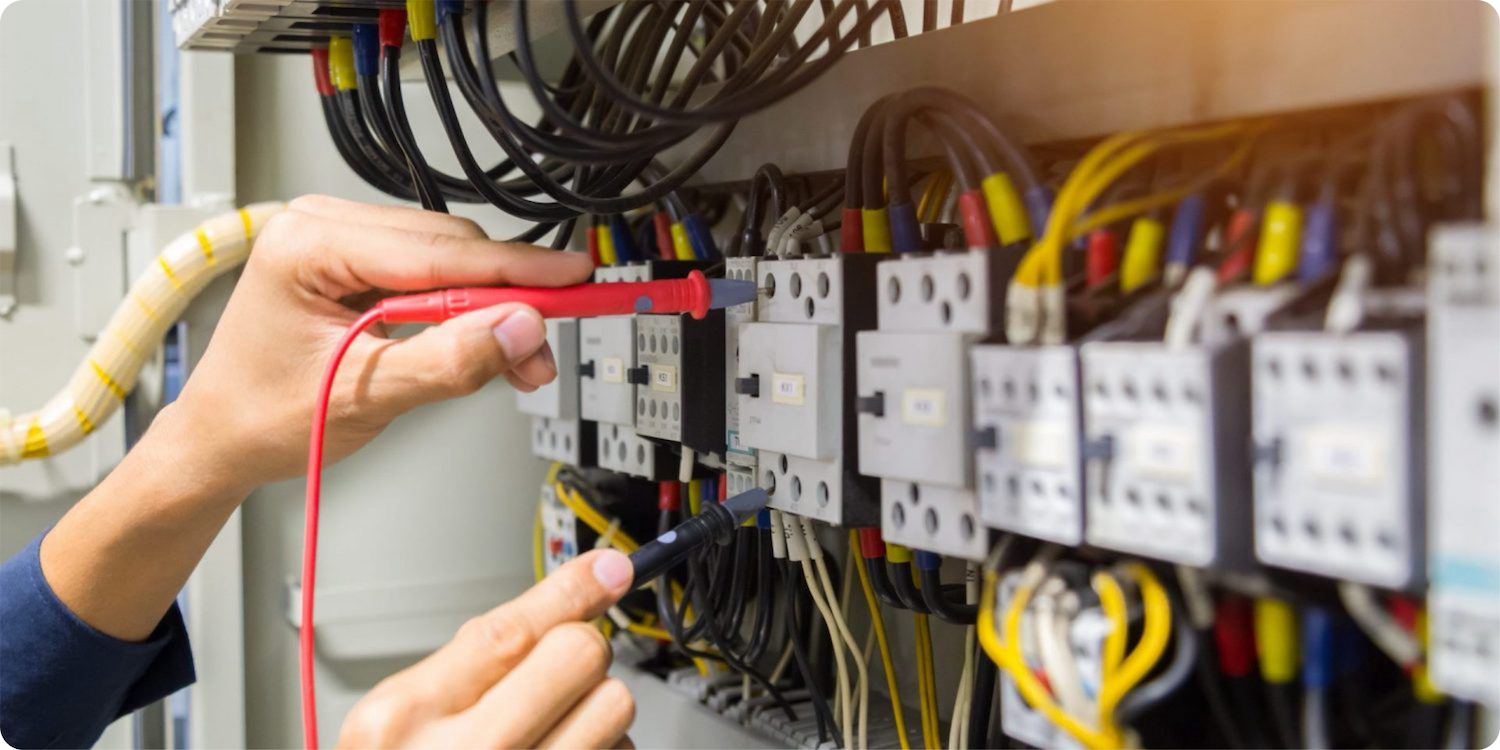
Electric System Models
Computer-based simulation models are used extensively to evaluate the ability of the electric system to accommodate new generation, changes in demand and changes in operational practices. An important role of electric system models is to demonstrate the ability of an electric system to recover from severe events or contingencies. Generic models of typical synchronous generators have been developed and validated over a period of multiple decades, and are used in industry standard software tools (e.g., power system simulators and analysis models) to study how the electric system and all its components will behave during system events or contingencies.
Similar generic models of wind turbines and wind power plants are in the process of being developed and validated. Because wind turbines have electrical characteristics that differ from typical synchronous generators, this modelling exercise requires significant effort. As a result, though considerable progress has been made, this progress is not complete, and increased deployment of wind energy will require improved and validated models to allow planners to better assess the capability of electric systems to accommodate wind energy.
Wind Power Electrical Characteristics and Grid Codes
As wind power capacity has increased, so has the need for wind power plants to become more active participants in maintaining (rather than passively depending on) the operability and power quality of the electric system.
Electric system models and operating experience are used to develop these requirements, which can then typically be met through modifications to wind turbine design or through the addition of auxiliary equipment such as power conditioning devices. In some cases, the unique characteristics of specific generation types are addressed in grid codes, resulting in wind-specific grid codes.
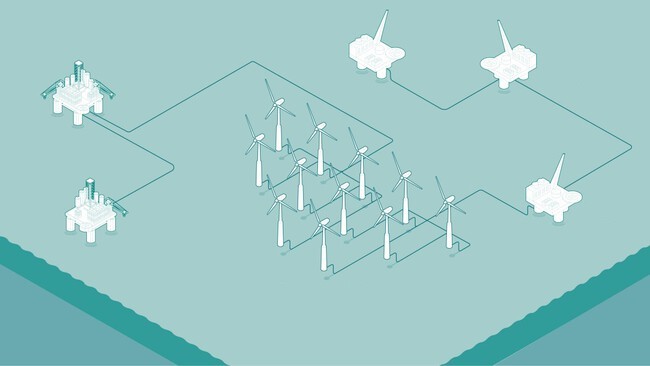
Grid codes often require ‘fault ride-through’ capability, or the ability of a wind power plant to remain connected and operational during brief but severe changes in electric system voltage. The requirement for fault ride-through capability was in response to the increasing penetration of wind energy and the significant size of individual wind power plants. Electric systems can typically maintain reliable operation when small individual power plants shut down or disconnect from the system for protection purposes in response to fault conditions.
When a large amount of wind power capacity disconnects in response to a fault, however, that disconnection can exacerbate the fault conditions. Electric system planners have therefore increasingly specified that wind power plants must meet minimum fault ride-through standards similar to those required of other large power plants. System-wide approaches have also been adopted: in Spain, for example, wind power output may be curtailed in order to avoid potential reliability issues in the event of a fault; the need to employ this curtailment, however, is expected to decrease as fault ride-through capability is added to new and existing wind power plants.
Reactive power control to help manage voltage is also often required by grid codes, enabling wind turbines to improve voltage stability margins particularly in weak parts of the electric system. Requirements for wind turbine inertial response to improve system stability after disturbances are less common, but are under consideration. Active power control (including limits on how quickly wind power plants can change their output) and frequency control are also sometimes required. Finally, controls can be added to wind power plants to enable beneficial dampening of inter-area oscillations during dynamic events.
Transmission Infrastructure
As noted earlier, the highest-quality wind resources (whether on- or offshore) are often located at a distance from electricity demand centres. As a result, even at low to medium levels of wind electricity penetration, the addition of large quantities of wind energy in areas with the strongest wind resources may require significant new additions or upgrades to the transmission system. Transmission adequacy evaluations must consider any tradeoffs between the costs of expanding the transmission system to access higher-quality wind resources and the costs of accessing lower-quality wind resources that require less transmission investment. In addition, evaluations of new transmission capacity need to account for the relative smoothing benefits of aggregating wind power plants over large areas, the amount of transmission capacity devoted to managing the remaining variability of wind power output, and the broader nonwind-specific advantages and disadvantages of transmission expansion.
Irrespective of the costs and benefits of transmission expansion to accommodate increased wind energy deployment, one of the primary challenges is the long time it can take to plan, site, permit and construct new transmission infrastructure relative to the shorter time it often takes to add new wind power plants. Depending on the legal and regulatory framework in any particular region, the institutional challenges of transmission expansion, including cost allocation and siting, can be substantial. Enabling increased penetration of wind electricity may therefore require the creation of regulatory and legal frameworks for proactive rather than reactive transmission planning.
Generation Adequacy
Though methods and objectives vary from region to region, generation adequacy evaluations are generally used to assess the capability of generation resources to reliably meet electricity demand. Planners often evaluate the long-term reliability of the electric system by estimating the probability that the system will be able to meet expected demand in the future, as measured by a statistical metric called the load-carrying capability of the system. Each electricity supply resource contributes some fraction of its nameplate capacity to the overall capability of the system, as indicated by the capacity credit assigned to the resource. Although there is not a strict, uniform definition of capacity credit, the capacity credit of a generator is usually a “system” characteristic in that it is determined not only by the generator’s characteristics but also by the characteristics of the electric system to which that generator is connected, particularly the temporal profile of electricity demand.
The contribution of wind energy to long-term reliability can be evaluated using standard approaches, and wind power plants are typically found to have a capacity credit of 5 to 40% of nameplate capacity. The correlation between wind power output and electrical demand is an important determinant of the capacity credit of an individual wind power plant. In many cases, wind power output is uncorrelated or is weakly negatively correlated with periods of high electricity demand, reducing the capacity credit of wind power plants; this is not always the case, however, and wind power output in the UK, for example, has been found to be weakly positively correlated with periods of high demand. These correlations are case specific as they depend on the diurnal, seasonal and yearly characteristics of both wind power output and electricity demand.
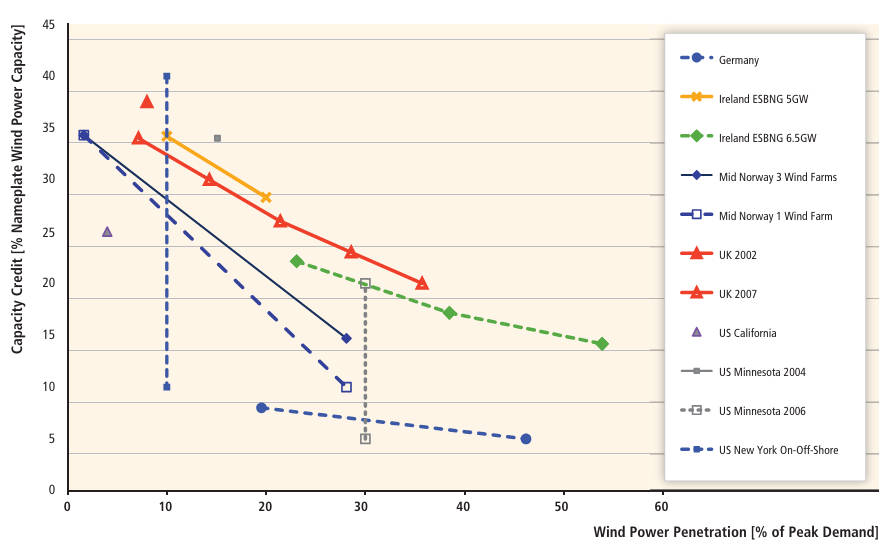
A second important characteristic of the capacity credit for wind energy is that its value generally decreases as wind electricity penetration levels rise, because the capacity credit of a generator is greater when power output is well-correlated with periods of time when there is a higher risk of a supply shortage. As the level of wind electricity penetration increases, however, assuming that the outputs of wind power plants are positively correlated, the period of greatest risk will shift to times with low average levels of wind energy supply.
Aggregating wind power plants over larger areas may reduce the correlation between wind power outputs, as described earlier, and can slow the decline in capacity credit as wind electricity penetration increases, though adequate transmission capacity is required to aggregate the output of wind power plants in this way.
The relatively low average capacity credit of wind power plants (compared to fossil fuel-powered units, for example) suggests that systems with large amounts of wind energy will also tend to have significantly more total nameplate generation capacity (wind and non-wind) to meet the same peak electricity demand than will electric systems without large amounts of wind energy. Some of this generation capacity will operate infrequently, however, and the mix of other generation in an electric system with large amounts of wind energy will tend (on economic grounds) to increasingly shift towards more flexible “peaking” and “intermediate” resources and away from “base-load” resources.
Though not an exhaustive list, four technical planning issues are prominent when considering increased reliance on wind energy: the need for accurate electric system models of wind turbines and power plants; the development of technical standards for connecting wind power plants with electric systems (i.e., grid codes); the broader transmission infrastructure needs of electric systems with wind energy; and the maintenance of overall generation adequacy with increased wind electricity penetration.

Electric System Models
Computer-based simulation models are used extensively to evaluate the ability of the electric system to accommodate new generation, changes in demand and changes in operational practices. An important role of electric system models is to demonstrate the ability of an electric system to recover from severe events or contingencies. Generic models of typical synchronous generators have been developed and validated over a period of multiple decades, and are used in industry standard software tools (e.g., power system simulators and analysis models) to study how the electric system and all its components will behave during system events or contingencies.
Similar generic models of wind turbines and wind power plants are in the process of being developed and validated. Because wind turbines have electrical characteristics that differ from typical synchronous generators, this modelling exercise requires significant effort. As a result, though considerable progress has been made, this progress is not complete, and increased deployment of wind energy will require improved and validated models to allow planners to better assess the capability of electric systems to accommodate wind energy.
Wind Power Electrical Characteristics and Grid Codes
As wind power capacity has increased, so has the need for wind power plants to become more active participants in maintaining (rather than passively depending on) the operability and power quality of the electric system.
Focusing here primarily on the technical aspects of grid connection, the electrical performance of wind turbines in interaction with the grid is often verified in accordance with international standards for the characteristics of wind turbines, in which methods to assess the impact of one or more wind turbines on power quality are specified. Additionally, an increasing number of electric system operators have implemented technical standards (sometimes called ‘grid codes’) that wind turbines and/or wind power plants (and other power plants) must meet when connecting to the grid to help prevent equipment or facilities from adversely affecting the electric system during normal operation and contingencies.
Electric system models and operating experience are used to develop these requirements, which can then typically be met through modifications to wind turbine design or through the addition of auxiliary equipment such as power conditioning devices. In some cases, the unique characteristics of specific generation types are addressed in grid codes, resulting in wind-specific grid codes.

Grid codes often require ‘fault ride-through’ capability, or the ability of a wind power plant to remain connected and operational during brief but severe changes in electric system voltage. The requirement for fault ride-through capability was in response to the increasing penetration of wind energy and the significant size of individual wind power plants. Electric systems can typically maintain reliable operation when small individual power plants shut down or disconnect from the system for protection purposes in response to fault conditions.
When a large amount of wind power capacity disconnects in response to a fault, however, that disconnection can exacerbate the fault conditions. Electric system planners have therefore increasingly specified that wind power plants must meet minimum fault ride-through standards similar to those required of other large power plants. System-wide approaches have also been adopted: in Spain, for example, wind power output may be curtailed in order to avoid potential reliability issues in the event of a fault; the need to employ this curtailment, however, is expected to decrease as fault ride-through capability is added to new and existing wind power plants.
Reactive power control to help manage voltage is also often required by grid codes, enabling wind turbines to improve voltage stability margins particularly in weak parts of the electric system. Requirements for wind turbine inertial response to improve system stability after disturbances are less common, but are under consideration. Active power control (including limits on how quickly wind power plants can change their output) and frequency control are also sometimes required. Finally, controls can be added to wind power plants to enable beneficial dampening of inter-area oscillations during dynamic events.
Transmission Infrastructure
As noted earlier, the highest-quality wind resources (whether on- or offshore) are often located at a distance from electricity demand centres. As a result, even at low to medium levels of wind electricity penetration, the addition of large quantities of wind energy in areas with the strongest wind resources may require significant new additions or upgrades to the transmission system. Transmission adequacy evaluations must consider any tradeoffs between the costs of expanding the transmission system to access higher-quality wind resources and the costs of accessing lower-quality wind resources that require less transmission investment. In addition, evaluations of new transmission capacity need to account for the relative smoothing benefits of aggregating wind power plants over large areas, the amount of transmission capacity devoted to managing the remaining variability of wind power output, and the broader nonwind-specific advantages and disadvantages of transmission expansion.
Irrespective of the costs and benefits of transmission expansion to accommodate increased wind energy deployment, one of the primary challenges is the long time it can take to plan, site, permit and construct new transmission infrastructure relative to the shorter time it often takes to add new wind power plants. Depending on the legal and regulatory framework in any particular region, the institutional challenges of transmission expansion, including cost allocation and siting, can be substantial. Enabling increased penetration of wind electricity may therefore require the creation of regulatory and legal frameworks for proactive rather than reactive transmission planning.
Generation Adequacy
Though methods and objectives vary from region to region, generation adequacy evaluations are generally used to assess the capability of generation resources to reliably meet electricity demand. Planners often evaluate the long-term reliability of the electric system by estimating the probability that the system will be able to meet expected demand in the future, as measured by a statistical metric called the load-carrying capability of the system. Each electricity supply resource contributes some fraction of its nameplate capacity to the overall capability of the system, as indicated by the capacity credit assigned to the resource. Although there is not a strict, uniform definition of capacity credit, the capacity credit of a generator is usually a “system” characteristic in that it is determined not only by the generator’s characteristics but also by the characteristics of the electric system to which that generator is connected, particularly the temporal profile of electricity demand.
The contribution of wind energy to long-term reliability can be evaluated using standard approaches, and wind power plants are typically found to have a capacity credit of 5 to 40% of nameplate capacity. The correlation between wind power output and electrical demand is an important determinant of the capacity credit of an individual wind power plant. In many cases, wind power output is uncorrelated or is weakly negatively correlated with periods of high electricity demand, reducing the capacity credit of wind power plants; this is not always the case, however, and wind power output in the UK, for example, has been found to be weakly positively correlated with periods of high demand. These correlations are case specific as they depend on the diurnal, seasonal and yearly characteristics of both wind power output and electricity demand.

A second important characteristic of the capacity credit for wind energy is that its value generally decreases as wind electricity penetration levels rise, because the capacity credit of a generator is greater when power output is well-correlated with periods of time when there is a higher risk of a supply shortage. As the level of wind electricity penetration increases, however, assuming that the outputs of wind power plants are positively correlated, the period of greatest risk will shift to times with low average levels of wind energy supply.
Aggregating wind power plants over larger areas may reduce the correlation between wind power outputs, as described earlier, and can slow the decline in capacity credit as wind electricity penetration increases, though adequate transmission capacity is required to aggregate the output of wind power plants in this way.
The relatively low average capacity credit of wind power plants (compared to fossil fuel-powered units, for example) suggests that systems with large amounts of wind energy will also tend to have significantly more total nameplate generation capacity (wind and non-wind) to meet the same peak electricity demand than will electric systems without large amounts of wind energy. Some of this generation capacity will operate infrequently, however, and the mix of other generation in an electric system with large amounts of wind energy will tend (on economic grounds) to increasingly shift towards more flexible “peaking” and “intermediate” resources and away from “base-load” resources.
Post a Comment:
You may also like:

Featured Articles
What Are the Advantages of Wind Energy?
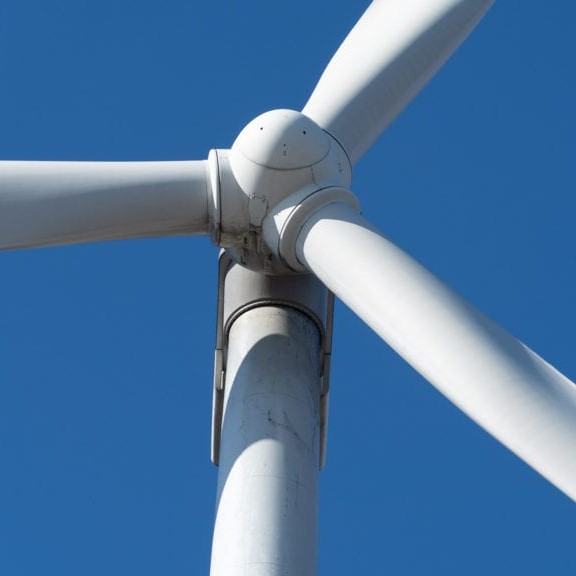 Wind power is the fastest-growing source of electricity worldwide. The American Wind Energy Association estimates that more ...
Wind power is the fastest-growing source of electricity worldwide. The American Wind Energy Association estimates that more ...
 Wind power is the fastest-growing source of electricity worldwide. The American Wind Energy Association estimates that more ...
Wind power is the fastest-growing source of electricity worldwide. The American Wind Energy Association estimates that more ...What is the Wind Energy Conversion ...
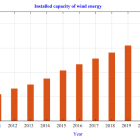 Due to technical and economic visibility, wind power has emerged as one of the most promising renewable energy sources ...
Due to technical and economic visibility, wind power has emerged as one of the most promising renewable energy sources ...
 Due to technical and economic visibility, wind power has emerged as one of the most promising renewable energy sources ...
Due to technical and economic visibility, wind power has emerged as one of the most promising renewable energy sources ...How Wind Energy is Collected and ...
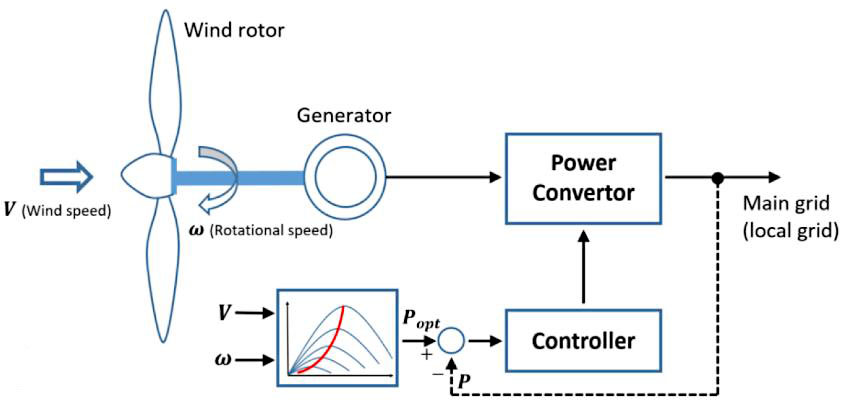 Wind energy is a form of solar energy. Earth’s atmosphere is unevenly heated by solar radiation and the air is in constant motion ...
Wind energy is a form of solar energy. Earth’s atmosphere is unevenly heated by solar radiation and the air is in constant motion ...
 Wind energy is a form of solar energy. Earth’s atmosphere is unevenly heated by solar radiation and the air is in constant motion ...
Wind energy is a form of solar energy. Earth’s atmosphere is unevenly heated by solar radiation and the air is in constant motion ...Technical Potential for Wind Energy
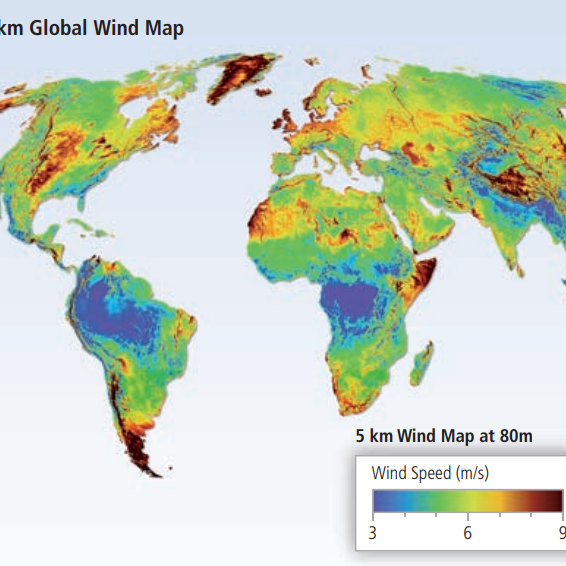 The theoretical potential for wind, as estimated by the global annual flux, has been estimated at 6,000 EJ/yr. The global ...
The theoretical potential for wind, as estimated by the global annual flux, has been estimated at 6,000 EJ/yr. The global ...
 The theoretical potential for wind, as estimated by the global annual flux, has been estimated at 6,000 EJ/yr. The global ...
The theoretical potential for wind, as estimated by the global annual flux, has been estimated at 6,000 EJ/yr. The global ...Wind Energy Background
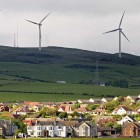 The kinetic energy in the wind is a promising source of renewable energy with significant potential in many parts of the world. ...
The kinetic energy in the wind is a promising source of renewable energy with significant potential in many parts of the world. ...
 The kinetic energy in the wind is a promising source of renewable energy with significant potential in many parts of the world. ...
The kinetic energy in the wind is a promising source of renewable energy with significant potential in many parts of the world. ...